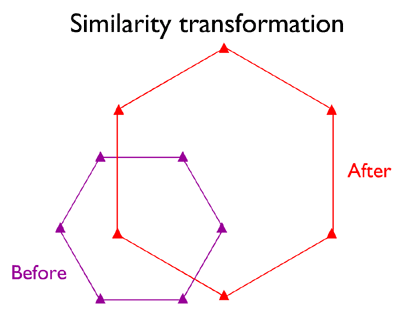
The types of transformation are reflection, rotation, translation and dilation. The proof makes use of similar triangles.B: A dilation with a quarter scale factor then a translation Walkthrough: EDG 2020Ī dilation with a scale factor of 4 then a translation Step by step explanation: Knowing that the vertices of the polygon ABCD are in A(-3, 3), B(5, 3), C(5, -1), D( 1, -5) while the vertices of the polygon A’B’C’D’ are in A'(-5, -2), B'(-3, 2), C'(-3, -3 ), D (-4, -4) Transformation is the movement of a point from its original location to a new location. The usual 'textbook' proof of the Euler Line Theorem uses the following construction. If O 2 is the center of similitude, construct a tangent to one of the circles, as above, but now we have the internal common tangent. The second tangent can be found by a reflection in P 1P 2 or by constructing the other intersection point. The constructed tangent must be tangent to the second circle. Then construct a tangent from that center to one of the circles. The cases when the circles are not disjoint need to be explored.Ĭonstruction of a common tangent to two circles. In each case the scale factor or similarity coefficient is the ratio of the two radii. In this case triangles O 2A 1P 1 and O 2B 2P 2 are similar. In a like manner, we could find another center of similitude by considering the point O 2 at the intersection of P1P2 and A1B2. The intersection O 1 of lines P 1P 2 and A 1A 2 will be the center of dilation for similar triangles O 1A 1P 1 and O 1A 2P 2. Given two circles and their centers P 1 and P 2.Ĭonstruct diameter A 2B 2.Construct parallel to A 2B 2 through P 1. Theorem: Any Two Circles with Different Radii are similar.Įssentially the proof is to show that dilations exist between any two given circles. Prove that the centers of dilation of three triangles that are pairwise centrally similar are collinear. Is it true that a similarity transformation is a composition of an isometry followed by a dilation? Justify.Ģ. Hence any similarity transformation is a composition of a dilation followed by an isometry?ġ. Therefore S k º C 1/k maps AB to an image with the same length as AB and hence it is an isometry. Now S k maps that image so that distances are multiplied by the constant k. Then by C 1/k AB is mapped to A'B' such that A'B' = AB. Since the point O for the dilation can be chosen at any point in the plane, let O be at A.

Let S k be a similarity translation with a scale factor k, and let C 1/k be a dilation about some point O.Ĭ 1/k maps every point P to a point on ray OP' such that OP' = OP. In a coordinate plane, if the center of the dilation is the origin, then the image of point (x,y) is (kx, ky).ġ. The image of the center of the circle is the center of the transformed circle, and the ratio of the radius of the transformed circle to the radius of the given circle is equal to the scale factor of the dilation.Į. Every triangle is transformed to a similar triangle, and consequently angle are transformed into congruent angles.ĭ. A line through O is transformed onto itself, and line not through O is transformed into a parallel line.Ĭ. A segment AB not belonging to the line through the center O is transformed on to the segment A'B' parallel to ABī. A dilation is a similarity transformation.Ī. When k < 0, P is mapped to P' on the opposite side of point O such that OP' = |k|OP.ġ. Why do you suppose the scale factor was defined to be a positive number? Note that we are dealing with distance.įor a dilation (or homothety or homothecy) the transformation is usually defined for k < 0 as well. O is called the center of similitude or the center of dilation.

If 0 0, assigns to each point P a point P' such that OP' = kOP (Note typo in book where this is given as OP' = kOA). If k = 1, the transformation is an isometry.

Is called a scale factor, or similarity ratio, or similarity coefficient, or. Overview of Section 5.4 Similarity transformations and constructionsĪ transformation S k of the plane that multiplies all distances by the same positive constant k is a similarity of the plane.


 0 kommentar(er)
0 kommentar(er)
